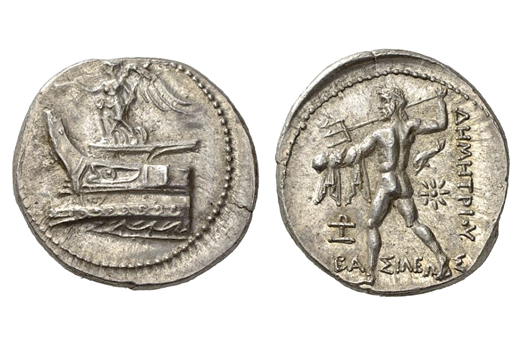
about ancient nomos
Ancient Nomos Art is a museum of galleries exhibiting ancient coins and ancient mint maps. The coin gallery displays the diverse art and history of hand-crafted ancient Greek, Roman, Byzantine, Persian and Medieval coinage. The ancient mints mapping gallery features Greek, Roman, Byzantine, Asia Minor and Medieval mint city regions and territories. Visitor's are welcome to explore, study and enjoy Ancient Nomos Art.

Greek, Pella – 294 BC
D. Poliorketes I
From Ancient Galleries

Obverse: Winged Nike blowing trumpet and holding stylis, standing alighting to the left on a left-facing galley prow.
Reverse: Poseidon Pelagaios standing nude to left with chlamys wrapped over left arm and preparing to throw a trident.
LEGEND SYMBOLS
Obv: Winged Nike, blowing trumpet and holding stylis, standing alighting to the left on a left-facing galley prow; sea waves along the ship’s hull; beaded border. Rev: BA–ΣIΛEΩ–Σ ΔHMHTPIOY, Poseidon Pelagaios standing nude to left with chlamys wrapped over left arm and wearing wreath of reeds, he is preparing to throw a trident; monogram ZΩ in lower left field; dolphin swimming left above 8-ray star in right field; beaded border.
The above ancient Greek coin is a bold, imaginative and wonderfully inspired “ship’s prow” silver tetradrachm of Macedonian King Demetrios I Poliorketes, struck circa 294 BC. Demetrios I Poliorketes was born in Macedonia and was the son of Antigonus I Monophthalmus, one of Alexander the Great’s outstanding generals, ruling satrap and Macedonian nobleman. Demetrios I served under his fathers command as a soldier and then as a general, on land and in the sea. Upon capturing Athens, Demetrios I had himself declared a divine liberator and reputedly installed his own personal harem on the Acropolis. One of the most famous incidents from his life was the siege he conducted against the city of Rhodes. For over a year Demetrios I tried to take the city, devising incredible siege engines. One such engine was a massive iron plated siege tower called Helepolis that apparently stood 130 feet tall and was mounted with numerous catapults. Despite his ingenuity, the city of Rhodes withstood the siege and Demetrios I returned unsuccessfully to the Greek mainland. The siege engines became a tourist attraction and visitors to the island paid to examine them. The people of Rhodes also constructed the famous Colossus to commemorate their victory. In 302 BC father and son were defeated at the battle of Ipsus and Antigonus I was killed. Demetrius, after many twists of fate, eventually made himself king of Macedon in 294 BC. This is the time he began issuing these superb tetradrachms, literally filled with mythical entertainment, triumphant promotion and truly the most aesthetically engaging of the Diadochi ancient coinage. The coin obverse depicts the winged Goddess Nike perched alighting and facing slightly left on a raised galley platform of a trireme ship’s left prow. Nike is seen triumphantly blowing her trumpet and hold steady her long stylis. Aegean Sea waves can be seen curling below the edge of the large cast bronze rostrum. The coin reverse depicts an image of Poseidon Pelagaios standing nude and to left with chlamys wrapped over his left arm. Poseidon is seen wearing a wreath of reeds as he is preparing to throw his long trident. Below his left arm is a monogram ZΩ (lower left field) and a dolphin swimming left below his right arm. An eight ray star is seen in the right field with the Greek legend BAΣIΛEΩΣ engraved horizontally and the legend ΔHMHTPIOY engraved vertically. While Demetrios I could win many battles, he was unable to claim victory and subsequent the spoils, eventually being driven from his Macedonian kingdom by the fighting legions of Pyrrhus, Lysimachos, and Ptolemy. Demetrios I took his army to Asia where his remaining Soldiers, after plundering a number of smaller provinces, were eventually decimated by sickness, starvation and the plague. Having lost all legions and resources, Demetrius I was captured by Seleukos I Nikator. Instead of being executed, Seleukos imprisoned Demetrios I in Syria and allowed him to live out his life in luxury, surrounded by women, wine and extravagant shelter. After a long career as general and ruler for over 20 years, Demetrios I died in 283 BC and his remains were returned to his son.
DOCUMENTATION
Value: Tetradrachm. Metal: AR Silver. Weight: 17.15 grams. Mint: Pella, Macedon. Date: Struck circa 294-293 BC.
Attribution: Dewing 1196; Newell, Demetrios I, 68 (same obverse dies LVII); SNG München 1042, variation (no dolphin; same obverse dies); Numismatica Ars Classica 77, The David Walsh Collection, 31.
Legend, Documentation and Attribution
